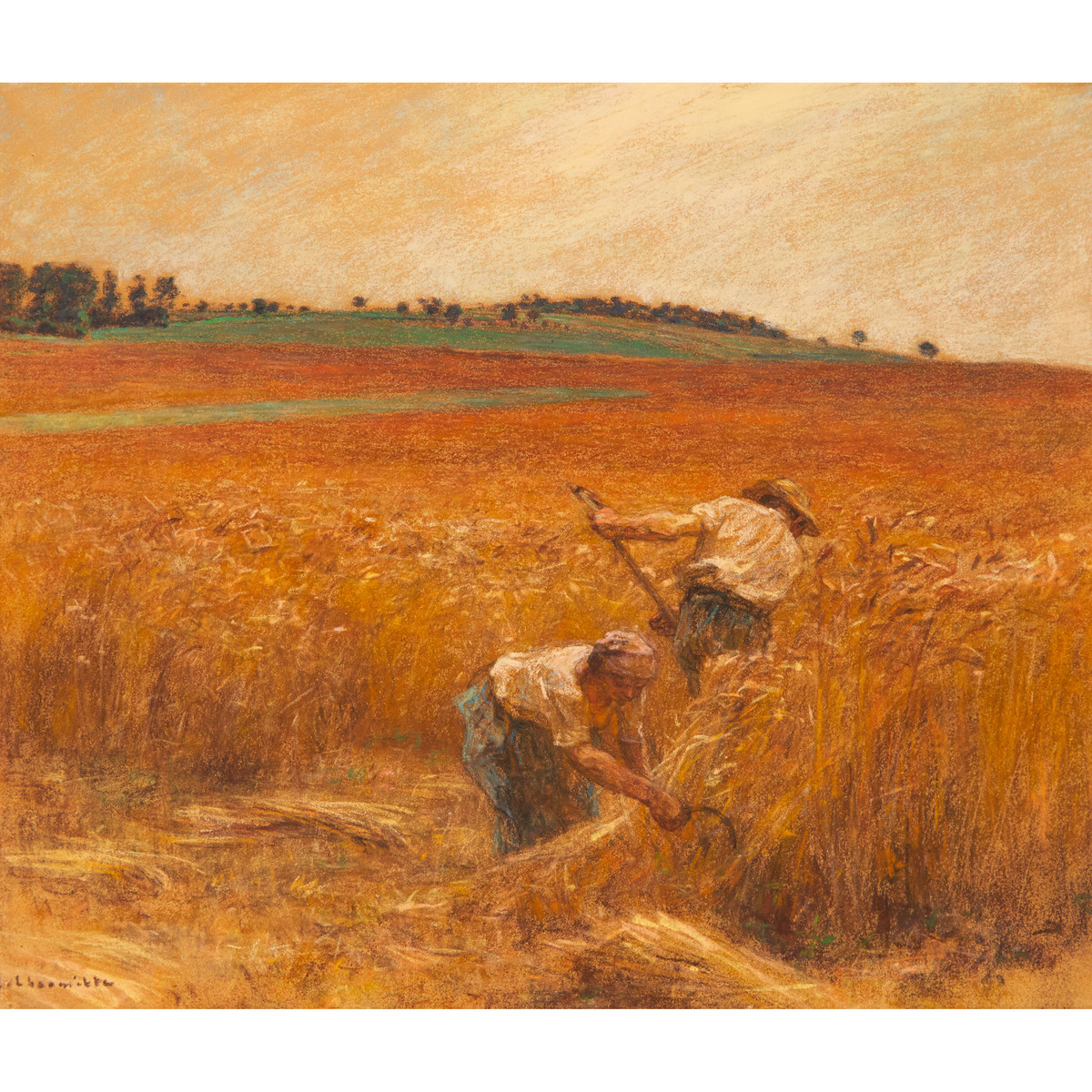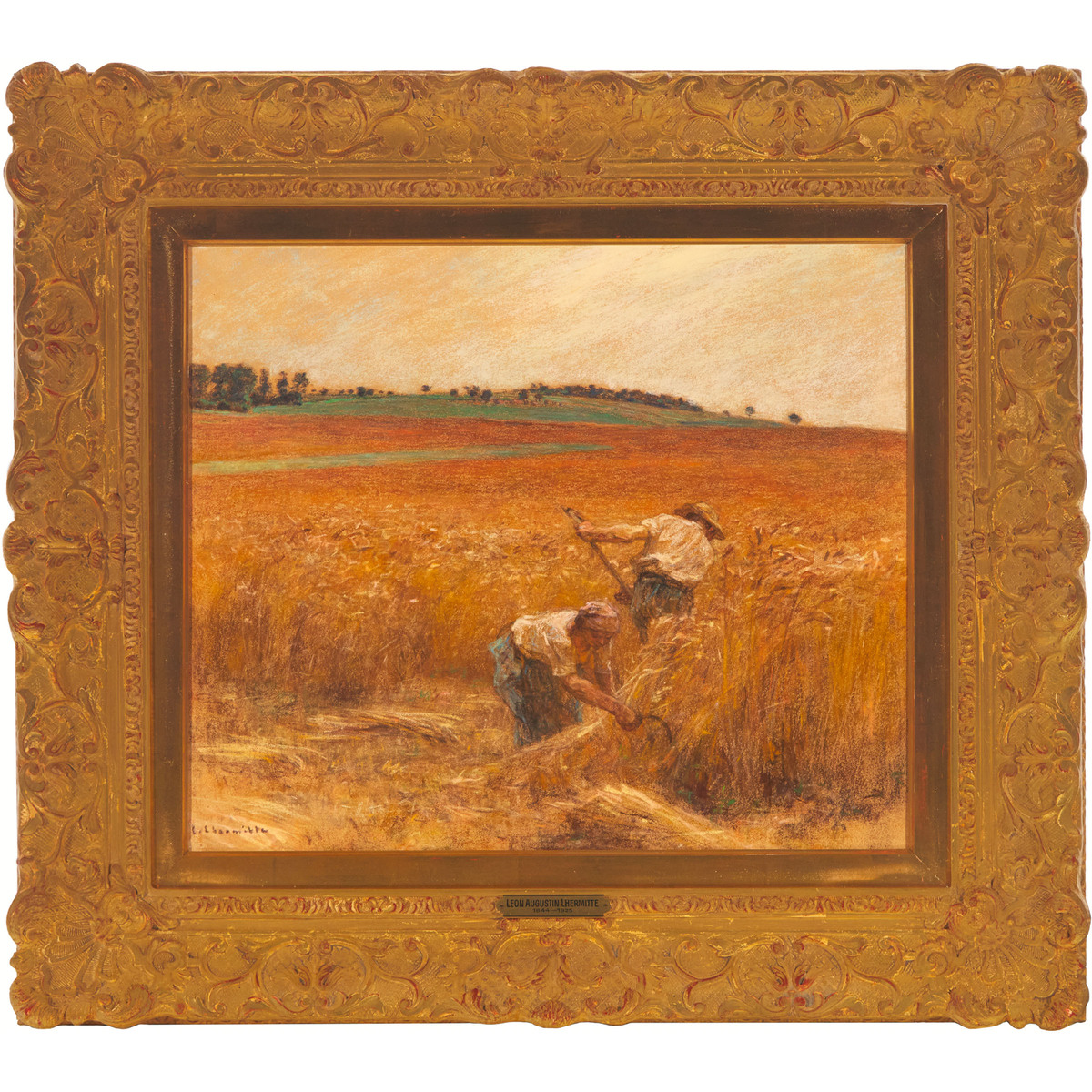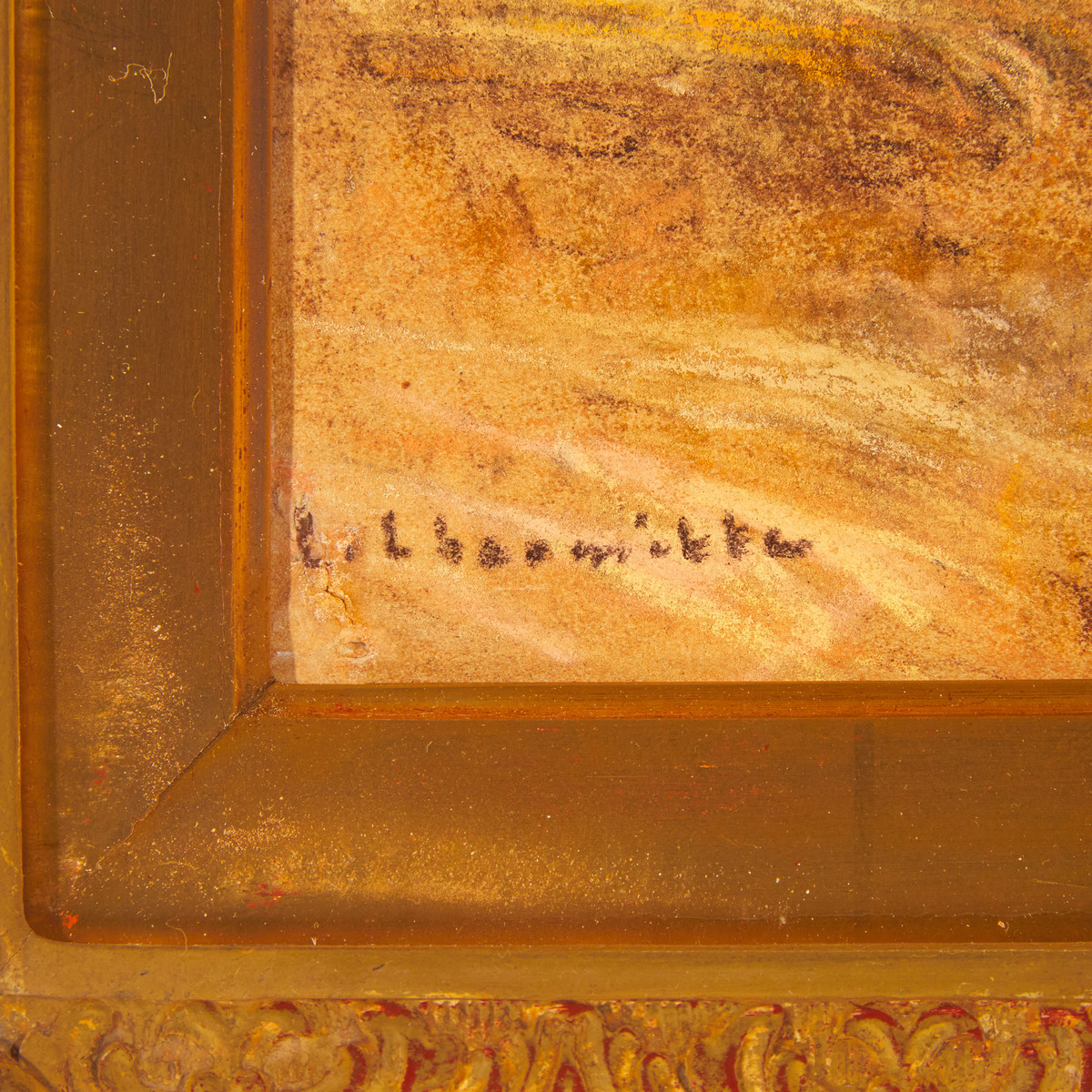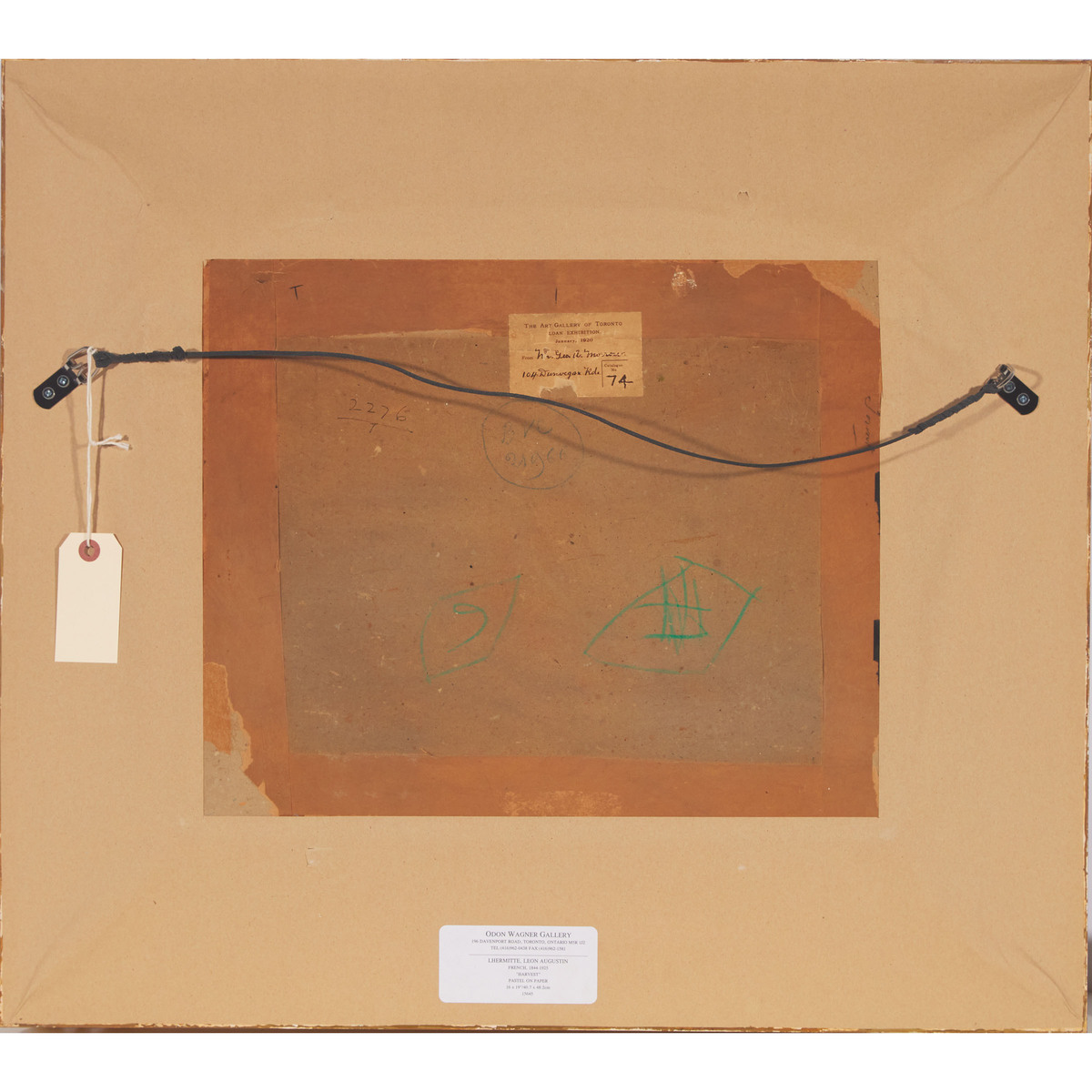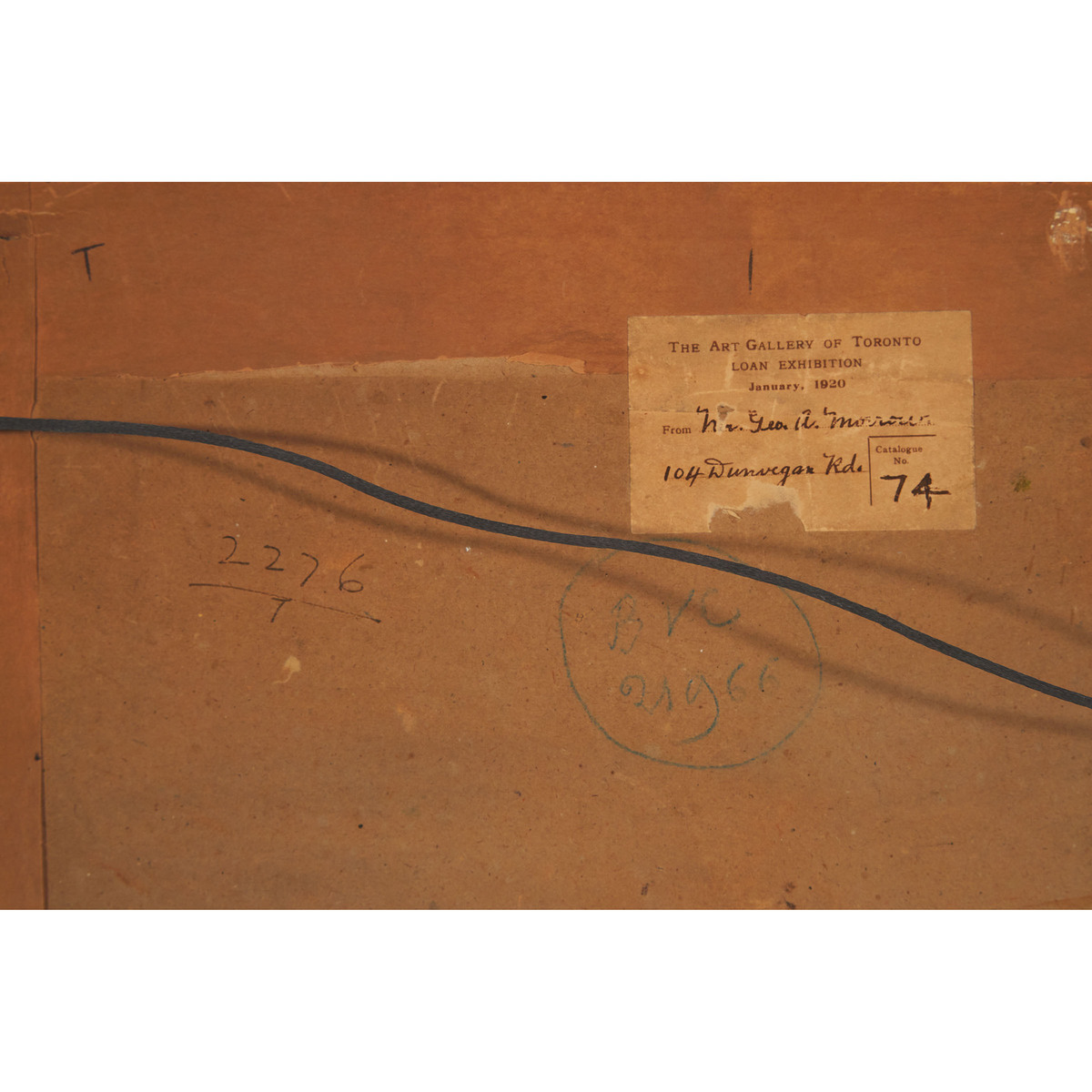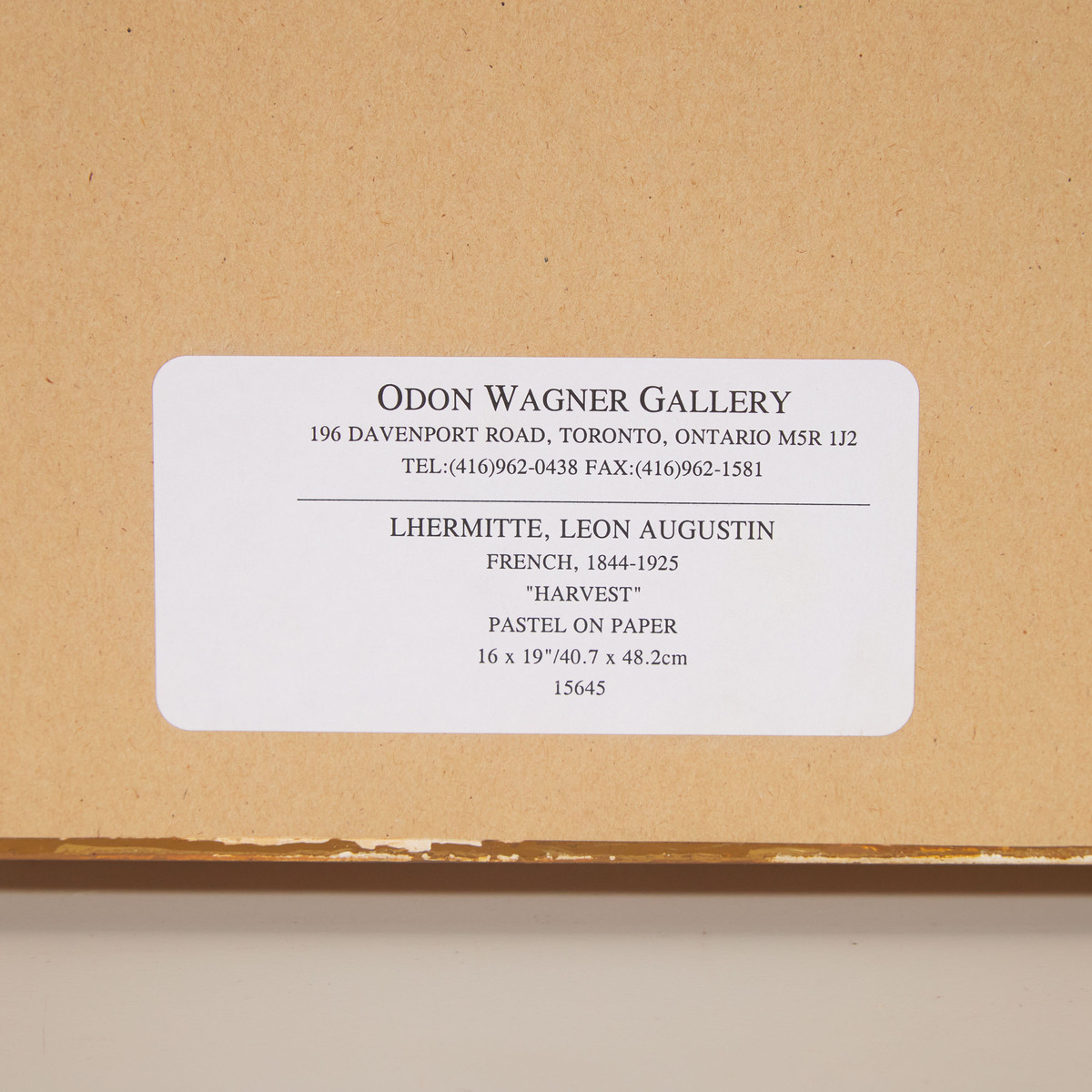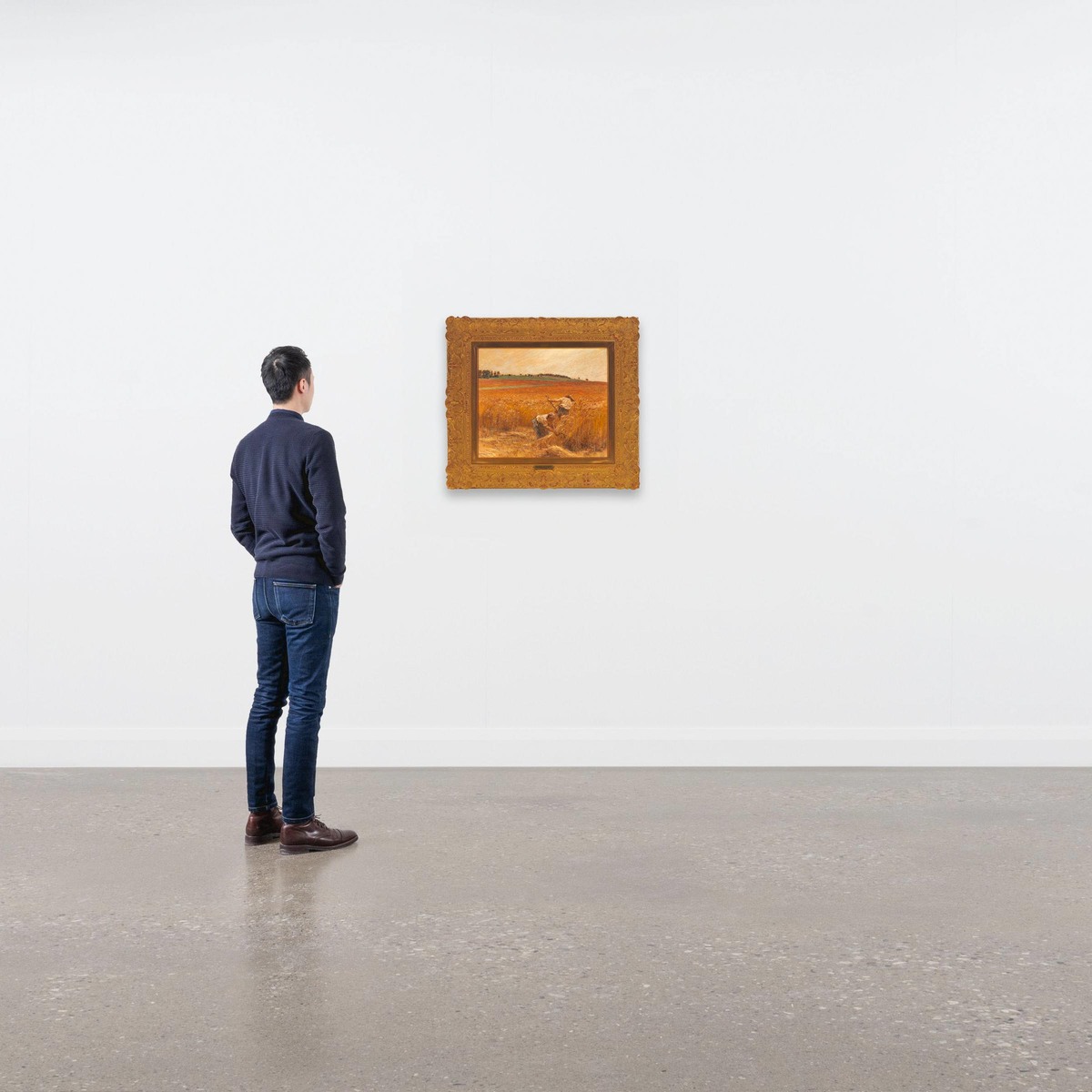18
Léon Augustin Lhermitte (1844-1925), HARVEST, signed lower left, 16 x 19 in — 40.6 x 48.3 cm
HARVEST
pastel on paper
signed lower left
16 x 19 in — 40.6 x 48.3 cm
Provenance:
Collection of George A. Morrow, Toronto, ON
Odon Wagner Gallery, Toronto, ON
S.P. Family Collection, Toronto, ON
Exhibited:
Art Gallery of Ontario, Jan 1920, Toronto, ON.
Note:
“[Léon Lhermitte] knows the figure in general – namely the sturdy, severe workman’s figure – through and through, and takes his subjects from the heart of the people.” – Vincent Van Gogh[1]
In 1874, at the age of 30, Léon-Augustin Lhermitte obtained his first medal at the Salon in Paris. His reputation was cemented with the oil on canvas La Paye des Moissonneurs (Paying the Harvesters) presented at the Salon in 1882 and purchased by the French government for the Musée du Luxembourg in Paris. In opposition to Romanticism, the Naturalist movement that Lhermitte was part of was emerging in France during the 1870s, pursuing the Realist wave shaped by Gustave Courbet and Jean-Francois Millet. Millet and his famous painting Les Glaneuses, 1857, would deeply impact Lhermitte. Millet’s influence can be felt in La Paye des Moissonneurs, which would be the turning point of Lhermitte’s career, as the financial success following the Salon would allow the artist to continue painting in a Naturalist style, now financially supported by a large number of collectors. Art world insiders also took note, including Vincent Van Gogh and the art dealer Paul Durand-Ruel.
With the second industrial revolution beginning in 1870, there was a great push towards a new way of life in the French capital with the arrival of electricity, gas and abundant fuel. This race towards progress was largely limited to Paris and other large cities, eluding the French countryside until the beginning of the 20th century. Accordingly, during the late 19th century, many parts of the country were left untouched, keeping agriculture largely frozen in time, as is evidenced by the field workers in the pastel The Harvest. In search of pristine landscapes and views, Lhermitte preferred to depict the rural parts of France he viewed as unsullied. Brittany was of particular interest, what with its unique way of life, complete with its own costumes, activities, celebrations, and palette. The artist depicted the local population without embellishment or idealisation: “to Lhermitte, rustic activity embodied dignity, for he believed workers in the fields seldom complained…Bolstering these ways of representing workers were the locales in which Lhermitte places his figures. The countryside was seldom dour or depressing, the atmosphere often appeared light and airy…and the environment seemed spacious.”[2]
Pastel depictions of golden wheat fields form the core of the artist’s production. Though pastel had dropped out of fashion for artists since the 17th century, the medium made a strong comeback during the 19th century, championed by Degas, Redon, Boudin and the Impressionists. Made by mixing powdered pigments with a white "filler," which may be kaolin or ground clay, and a "binder" whose role is to hold everything together, pastel allowed artists to capture an instant image of a scene without the need to fuss with paint and selecting the right palette. Committed to this discipline, Lhermitte created a group named “Les pastellistes” and would help to train the next generation of young artists following in his footsteps.
Influenced by the Realists and the Impressionists, Lhermitte depicted a vanishing era, which he attempted to do without any explicit political agenda. For the artist, fieldworkers were the embodiment of life in the countryside, a life he saw as happy due to its distance from the chaos of the city and its rapid industrialization.[3] With his pastels, Lhermitte was able to represent the working life of individuals without judgement, deeply focusing on the subject or subjects at hand, the landscape and the effects of light.
[1] https://www.vangoghmuseum.nl/en/collection/s0424M1991: “Van Gogh too hoped to establish himself as a painter of peasant life, and so Lhermitte’s work was an important source of inspiration to him. He regularly asked his brother Theo to send him reproductions of Lhermitte’s paintings.”
[2] Gabriel Weisberg, “Léon Lhermitte: Creativity in Context,” in Léon Lhermitte, ex. cat. Galerie Michael, 1989.
[3] “Lhermitte was appreciated because he represented the 'good old days.' …Throughout his life Lhermitte pointedly ignored the Industrial Revolution, fixing instead on the image of society before its disappearance, the vision of a paradise lost for the citizens of big cities, of a time frozen outside the march of history.” in Monique Le Pelley Fontenay, Léon Lhermitte Catalogue Raisonné, Paris, 1991.
Estimate: $20,000—30,000
HARVEST
pastel on paper
signed lower left
16 x 19 in — 40.6 x 48.3 cm
Provenance:
Collection of George A. Morrow, Toronto, ON
Odon Wagner Gallery, Toronto, ON
S.P. Family Collection, Toronto, ON
Exhibited:
Art Gallery of Ontario, Jan 1920, Toronto, ON.
Note:
“[Léon Lhermitte] knows the figure in general – namely the sturdy, severe workman’s figure – through and through, and takes his subjects from the heart of the people.” – Vincent Van Gogh[1]
In 1874, at the age of 30, Léon-Augustin Lhermitte obtained his first medal at the Salon in Paris. His reputation was cemented with the oil on canvas La Paye des Moissonneurs (Paying the Harvesters) presented at the Salon in 1882 and purchased by the French government for the Musée du Luxembourg in Paris. In opposition to Romanticism, the Naturalist movement that Lhermitte was part of was emerging in France during the 1870s, pursuing the Realist wave shaped by Gustave Courbet and Jean-Francois Millet. Millet and his famous painting Les Glaneuses, 1857, would deeply impact Lhermitte. Millet’s influence can be felt in La Paye des Moissonneurs, which would be the turning point of Lhermitte’s career, as the financial success following the Salon would allow the artist to continue painting in a Naturalist style, now financially supported by a large number of collectors. Art world insiders also took note, including Vincent Van Gogh and the art dealer Paul Durand-Ruel.
With the second industrial revolution beginning in 1870, there was a great push towards a new way of life in the French capital with the arrival of electricity, gas and abundant fuel. This race towards progress was largely limited to Paris and other large cities, eluding the French countryside until the beginning of the 20th century. Accordingly, during the late 19th century, many parts of the country were left untouched, keeping agriculture largely frozen in time, as is evidenced by the field workers in the pastel The Harvest. In search of pristine landscapes and views, Lhermitte preferred to depict the rural parts of France he viewed as unsullied. Brittany was of particular interest, what with its unique way of life, complete with its own costumes, activities, celebrations, and palette. The artist depicted the local population without embellishment or idealisation: “to Lhermitte, rustic activity embodied dignity, for he believed workers in the fields seldom complained…Bolstering these ways of representing workers were the locales in which Lhermitte places his figures. The countryside was seldom dour or depressing, the atmosphere often appeared light and airy…and the environment seemed spacious.”[2]
Pastel depictions of golden wheat fields form the core of the artist’s production. Though pastel had dropped out of fashion for artists since the 17th century, the medium made a strong comeback during the 19th century, championed by Degas, Redon, Boudin and the Impressionists. Made by mixing powdered pigments with a white "filler," which may be kaolin or ground clay, and a "binder" whose role is to hold everything together, pastel allowed artists to capture an instant image of a scene without the need to fuss with paint and selecting the right palette. Committed to this discipline, Lhermitte created a group named “Les pastellistes” and would help to train the next generation of young artists following in his footsteps.
Influenced by the Realists and the Impressionists, Lhermitte depicted a vanishing era, which he attempted to do without any explicit political agenda. For the artist, fieldworkers were the embodiment of life in the countryside, a life he saw as happy due to its distance from the chaos of the city and its rapid industrialization.[3] With his pastels, Lhermitte was able to represent the working life of individuals without judgement, deeply focusing on the subject or subjects at hand, the landscape and the effects of light.
[1] https://www.vangoghmuseum.nl/en/collection/s0424M1991: “Van Gogh too hoped to establish himself as a painter of peasant life, and so Lhermitte’s work was an important source of inspiration to him. He regularly asked his brother Theo to send him reproductions of Lhermitte’s paintings.”
[2] Gabriel Weisberg, “Léon Lhermitte: Creativity in Context,” in Léon Lhermitte, ex. cat. Galerie Michael, 1989.
[3] “Lhermitte was appreciated because he represented the 'good old days.' …Throughout his life Lhermitte pointedly ignored the Industrial Revolution, fixing instead on the image of society before its disappearance, the vision of a paradise lost for the citizens of big cities, of a time frozen outside the march of history.” in Monique Le Pelley Fontenay, Léon Lhermitte Catalogue Raisonné, Paris, 1991.
Estimate: $20,000—30,000
Canadian and International Fine Art
Ends from
Venue Address
For Waddington's delivery information please telephone +1 4165049100.
Important Information
Our spring offering of Canadian and International Fine Art brings together exceptional work from around the world. This auction features celebrated Canadian artists such as Cornelius Krieghoff, A.Y. Jackson, P.C. Sheppard, A.J. Casson, Bertram Booker, Alexandra Luke, Jean Paul Lemieux and Yves Gaucher as well as important First Nations artists Norval Morrisseau, Roy Thomas and Alex Janvier. International highlights include work by Jules Olitski, Karel Appel, Kwon Young-Woo, Norman Bluhm, Józef Bakoś, Léon Lhermitte and Montague Dawson.
Please contact us to find out more.
Terms & Conditions
1. Waddington's charges a buyer's premium of 25% on the hammer price up to and including
$25,000 CAD. Hammer price in excess of $25,000 CAD will be charged a buyer's premium of
22%.
Bidders buying on the Invaluable site will be charged a buyer's premium of 28% on the hammer
price up to and including $25,000 CAD. Hammer prices in excess of $25,000 CAD will be
charged at 25%.
2. Unless exempted by law, the buyer is required to pay Federal Good and Services Tax on the
total purchase price including the buyer’s premium.
3. The auctioneer reserves the right to withdraw any lot from sale at any time, to divide any lot
or to combine any two or more lots at his sole discretion, all without notice.
4. The auctioneer has the right to refuse any bid and to advance the bidding at his absolute
discretion. The auctioneer reserves the right not to accept and not to reject any bid. Without
limitation, any bid which is not commensurate with the value of the article offered, or which is
merely a nominal or fractional advance over the previous bid may not be recognized.
5. Each lot may be subject to an unpublished reserve which may be changed at any time by
agreement between the auctioneer and the consignor. The auctioneer may bid, or direct an
employee to bid, on behalf of the consignor as agreed between them. In addition, the auctioneer
may accept and submit absentee and telephone bids, to be executed by an employee of the
auctioneer, pursuant to the instructions of prospective purchasers not in attendance at the sale.
6. The highest bidder accepted by the auctioneer for any lot shall be the buyer and such buyer
shall forthwith assume full risk and responsibility for the lot and must comply with such other
Conditions of Sale as may be applicable. If any dispute should arise between bidders the
auctioneer shall have the absolute discretion to designate the buyer or, at his option, to
withdraw any disputed lot from the sale, or to re-offer it at the same or a subsequent sale. The
auctioneer’s decision in all cases shall be final.
7. Immediately after the purchase of a lot, the buyer shall pay or undertake to the satisfaction of
the auctioneer with respect to payment of the whole or any part of the purchase price requested
by the auctioneer, failing which the auctioneer in his sole discretion may cancel the sale, with or
without re-offering the item for sale.
8. The buyer shall pay for all lots within 48 hours from the date of the sale, after which a late
charge of 2% per month on the total invoice may be incurred or the auctioneer, in his sole
discretion, may cancel the sale. The buyer shall not become the owner of the lot until paid for in
full. Items must be removed within 10 days from the date of sale, after which storage charges
may be incurred.
9. Each lot purchased, unless the sale is cancelled as above, shall be held by the auctioneer at
his premises or at a public warehouse at the sole risk of the buyer until fully paid for and taken
away.
10. All lots are sold “AS IS”. Any description issued by the auctioneer of an article to be sold is
subject to variation to be posted online and/or announced via email prior to the time of sale.
While the auctioneer has endeavored not to mislead in the description issued, and the utmost
care is taken to ensure the correct cataloguing of each item, such descriptions are purely
statements of opinion and are not intended to constitute a representation to the prospective
purchasers and no warranty of the correctness of such description is made. Some lots are of an
age and/or nature which preclude their being in pristine condition and some catalogue
descriptions make reference to damage and/or restoration. The lack of such a reference does
not imply that a lot is free from defects nor does any reference to certain defects imply the
absence of others. It is the responsibility of prospective purchasers to inspect or have inspected
each lot upon which they wish to bid and to bid accordingly.
11. Payment for purchases must be by cash; INTERAC direct debit (CDN client in person only);
certified cheque (U.S. & Overseas not applicable); bank draft; E-Transfer; Wire Transfer (fee
applies); VISA or Mastercard (up to $25,000).
12. In the event of failure to pay for or remove articles within the aforementioned time limit, the
auctioneer, without limitation of the rights of the consignor and the auctioneer against the buyer,
may resell any of the articles affected, and in such case the original buyer shall be responsible
to the auctioneer and the consignor for:
(a) any deficiency in price between the re-sale amount and the amount to have been paid by
the original buyer
(b) any reasonable charge by the auctioneer for the storage of such articles until payment and
removal by the subsequent buyer and
(c) the amount of commission which the auctioneer would have earned had payment been
made in full by the original buyer.
13. It is the responsibility of the buyer to make all arrangements for insuring, packing and
removing the property purchased and any assistance by the auctioneer or his servants, agents
or contractors, in packing or removal shall be rendered as a courtesy and without any liability to
them.
14. The auctioneer acts solely as agent for the consignor and makes no representation as to
any attribute of, title to, or restriction affecting the articles consigned for sale. Without limitation,
the buyer understands that any item bought may be affected by the provisions of the Cultural
Property Export Act (Canada).
15. The auctioneer reserves the right to refuse admission to the sale or to refuse to recognize
any or all bids from any particular person or persons at any auction.


















